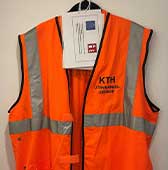Evacuation procedures
Important to know about evacuation at EECS.
Evacuation plans
Available on every floor.
Evacuation
KTH's appointed evacuation officers wear alert orange vests marked “utrymningsledare”. The evacuation officer has the task of helping out with evacuation in case he/she is present in the premises.

As we now work in a hybrid everyday life where you are not on site every day, it does not always work to have designated evacuation leaders. The new routine means that everyone has an obligation to help in an evacuation. As most of you have already seen, evacuation jackets hang in the departments in strategic places with an instruction on each jacket how to act in case of evacuation.
The routine
- Put on the vest.
- Make sure colleagues go out and gather at the assembly point.
- Make sure that no one enters the house before the rescue manager has approved it.
In the event of a fire, the Rescue Services' primary task is to save human lives. The emergency services need to be informed as soon as possible if there are people left in a burning building, for example, a person with a disability who has difficulty getting out if elevators are not to be used. Then it is of the utmost importance that a routine exists so that this information is immediately provided to the Rescue Services' rescue leader. The evacuation officers who have a person with a disability within their area of responsibility must prepare a routine that ensures that the person can get help with evacuation if the situation arises.
Actions at evacuation, fire
- Find out what has happened and try, without risking your own life, to extinguish or limit the fire.
- Call 112 and call 790 7700 (KTH's emergency number)
- Order immediate evacuation:
- Guide towards a suitable smoke-free escape route
- Do not discuss with anyone who does not want to evacuate but move on
- Check the toilets and any changing rooms
- Leave last and report to Fire Protection Officer, KTH's security group or Rescue Officer
- Ensure that exterior doors are guarded so that no one enters the building as long as danger exists.
Remedy for evacuation in case of not fire, for example toxic gas
- If the building has an evacuation alarm or fire alarm, activate the alarm.
- Call 112 and call 08-790 7700 (KTH's emergency number)
- Order immediate evacuation:
- Guide towards suitable escape route
- Has everyone understood the situation?
- Create a calm atmosphere
- Do not discuss with anyone who does not want to evacuate but move on
- Check toilets and any changing rooms
- Leave last and report to Fire Protection Officer, KTH's security group or the Rescue Leader
- Ensures that exterior doors are guarded so that no one enters the building as long as danger exists
Actions after evacuation
Provide the information below to the rescue services via the Fire Protection Officer, KTH's security group or directly to the Rescue Leader:
- Which premises are checked?
- If the premises were empty or if there were people left in the premises when the Evacuation Officer left
- If knowledge exists regarding the cause of the evacuation
In case of fire:
- Known risks to the rescue service, eg acetylene gas bottles
- Valuable equipment or information that is important to prioritize in the extinguishing operation
The accident site
- In the event that the Rescue Leader decides that an area should be vacated, KTH Valhallavägen's assembly point is KTH's sports hall.
- KTH's security group, Fire Protection Officer or Evacuation Officer, in the specified order, shall be at the disposal of the Rescue Leader.
- Re-entry into a vacant building takes place only after the Rescue Leader's clearance. Re-entry may not take place when the alarm bells are silenced but ONLY when the Rescue Services has given a clear sign. It is conceivable that the Rescue Service silences the alarm bells so as not to be disturbed by the sound when they make their efforts.
- The Evacuation Officer is allowed to inform according to point above and inform the evacuees about what is happening and what is to happen.
